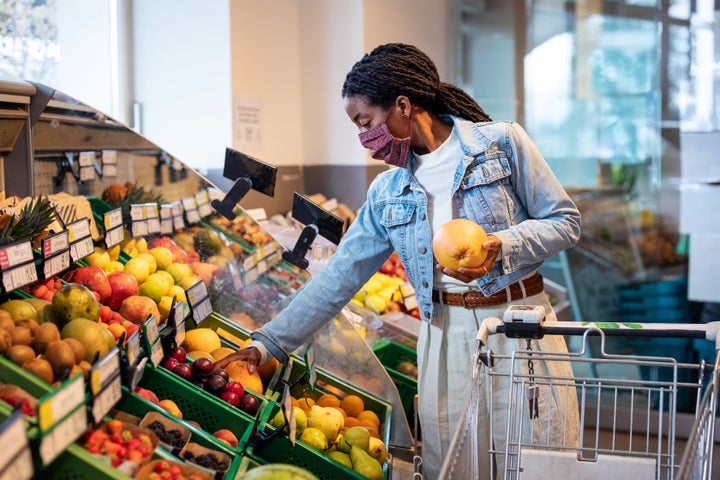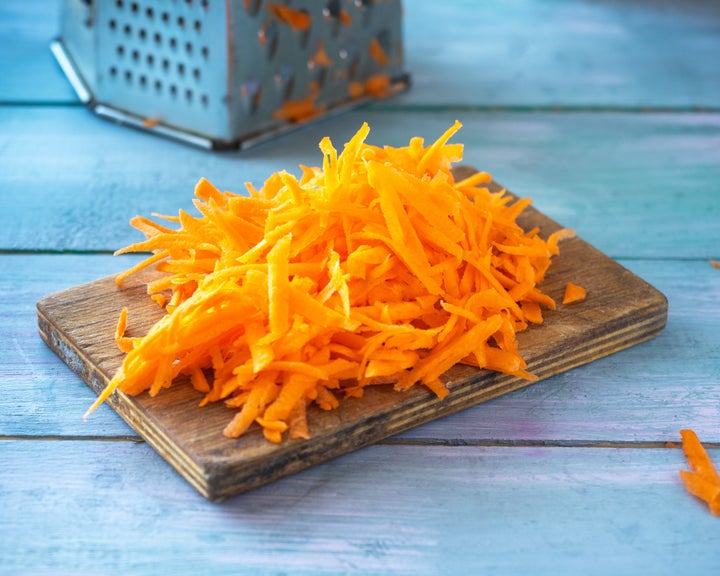Let’s be honest: Some of us have still not yet fully recovered from the early days of the pandemic, when bread flew off the shelves, chicken was scarce and hardly a soul could “spare a square” of precious toilet paper.
“In March, there was initial stockpiling of key grocery items due to panic buying, and consumers continued to buy more groceries to eat at home due to safety concerns as well as closures of restaurants and capacity limitations in dining rooms,” said Terrie Wendricks, vice president of consumer and shopper insights at C+R Research.
Prices shot up in response, making grocery shopping — already a bit of a stressful ordeal — even more difficult.
“Grocery shopping today is a whole new experience that can create some pretty high anxiety for some of us,” said Kim Anderson, clinical director of the Eating Recovery Center of Maryland.
“For those struggling with or in recovery from an eating disorder, they might experience heightened anxiety that the grocery store may trigger certain thoughts or behaviors,” she added. “If people have lost income due to the pandemic, the grocery store may bring up anxiety around being able to provide for themselves and their families.”
But, Anderson said, any shopper can experience pressure or tension about being around several people in the store, making sure they have appropriate protective gear like hand sanitizer, following new store policies like one-way foot traffic, and realizing what they need isn’t in stock.

Although there’s a lot to unpack in terms of stressors for grocery shopping these days, there are at least a few ways to mitigate the concerns.
Buying in bulk doesn’t always save you money.
Big boxes and bulk can be counted on for the lowest prices, right? After all, their business model is based on selling things close to cost … right? Wrong.
Many people assume that club membership venues and mass superstore retailers have the most competitive pricing due to the volume of their orders, but this is actually not always the case. Certain items are great buys at these mega retailers, drawing in consumers with “can-you-believe-this-price” deals that lull them into a sense of low-cost security. These are called loss leaders, and you may recognize them in the form of $4.99 rotisserie chickens, $9.99 pizzas or “everyday value” offers. However, be aware that stores make up the money elsewhere, charging the same rate per unit as dedicated grocery stores but getting you to spend more due to larger packages.
For example, boneless chicken breasts sell for roughly $3 a pound at Costco, but can go on sale for as little as 99 cents per pound at regional supermarkets. Typically, they average about $2 per pound during regular weekly promotions at regional grocery chains. Bananas may sound super cheap at a quarter each at Target, but they’re often around 50 cents a pound at a regular grocery store, which can be even less per banana depending on the size.
Download apps that help you determine when prices are reasonable.
If you’re new to doing most of your cooking at home, the cost of certain ingredients can be shocking — in either direction. Who knew that you could buy five pounds of potatoes for as little as $2 and an on-sale pack of pork chops for about a little more than buck per person? But also, who knew that salad dressing ranges from $1 to $6 each, sliced cold cuts can be a whopping $11 a pound, and that ― for the love of God! ― there are so many cuts of beef, priced from $1.99 a pound for London broil to $20-plus a pound for aged cuts from the case?

With such a wide selection of brands, specialty spin-off variants and packaging available, it’s hard for the infrequent shopper to gauge what’s average. However, a new app called Basket can help with that. Similar to Gas Buddy, it relies on the input of shoppers in the area to help you determine if you’re paying more or less than others. You just add what you’re looking at to your list, pick a brand (or choose the generic option), then hit “Compare Prices” to view how much other local markets are selling the same product for. You can scroll down to make sure the price you’re looking at is fair, inflated, or on promo just a few miles down the road … and if it’s worth making the extra stop.
Apps can also help you shop sales at your local grocery chains.
Another helpful app is Flipp, an extremely easy, visual way to shop your local circulars.
Most of the major regional chains, as well as some other specialty markets, can be found on Flipp. Stores’ weekly flyers are uploaded either the day before or the day of a sale launch and look exactly like the ones you used to get in the mail. Just tap on the advertised items you want to buy to add them to your digital grocery list.
This makes it immensely easy to comparison shop since your grocery list is laid out with product images side-by-side. To make it even more user-friendly, a search function lets you compare sale prices across all the stores in your area if you’re looking for a specific product. A new feature even allows you to add store coupons; however, its interface is a bit messy right now for coupons that can be used multiple times, making your grocery list kind of interminable.
Get deals from the app for your preferred market you shop.
That leads us to the next set of apps you ought to have in your grocery shopping arsenal: brand-specific ones. They’re designed to build customer loyalty, and typically come with extra perks and opportunities for saving. They also store digital coupons to your account so savings are automatically applied to your order when you input your phone number at check-out. Kroger, Publix and ShopRite are among the stores that boast this feature, and a few go a step further to offer bonus savings specifically for your account. For example, Stop & Shop offers points toward Shell gas station fuel purchases and Lidl releases rewards at different spending thresholds that unlock extra discounts on specific products or credit toward your next order.
In-season produce will save you money.
Agriculture is still mostly highly dependent on natural climate cycles — and if the farmers and distributors don’t use the product, they lose the profit. Therefore, pricing is most aggressively low on produce during the height of crop harvesting, allowing you to eat in peak for cheap.
Be flexible with your eating habits to take best advantage of seasonal fruits and vegetables. Switch from broccoli to zucchini and green beans for your summer meal prep. Stock up on sweet potatoes in the fall. Save your Brussels sprouts cravings for the autumn, skip berries with your breakfast until summer and make tomatoes your warm-weather superstars while they’re at rock-bottom rates.
Of course, there are goods that are grown in the tropics that you can get affordably year-round, such as bananas and pineapples, and greens whose prices stay pretty stable, such as cabbage and carrots. But by planning your menu based on the sales, you’ll be receiving the double benefit of getting the freshest produce for cheap, as well as introducing some fun variation to your meals for a more nutritionally beneficial diet.
Avoid prechopped, precooked foods.
It’s been a long day/week/month/year, and yeah, we’re all tired. It’s tempting to reach for the presliced onions and peppers, the chopped broccoli florets, the coleslaw mix, bagged cut lettuce, marinated steaks and already-grilled chicken. Anything, really, from the multibillion-dollar industry that has been created around making food prep more convenient. But if you can muster up the extra five minutes to prep, you could be saving yourself a few dollars.

There are several benefits to dealing with your raw materials yourself, the first being the price per pound. For instance, in a store-packaged tray of sliced “fajita mix” onions and peppers, your yield is typically the equivalent of one or two onions and a bell pepper, valued at roughly $1.50 on average at 50 cents a pound for an onion and a dollar for a single green pepper. However, even though it may not feel like you’re paying much for the package, the price per pound in the store-prepped pack will run you up to $5 a pound for a high premium on this minimal prep.
Along those lines, a two-pound bag of cut broccoli florets will go on sale for $6, which is as much as triple what you’d pay for a crown on sale at 99 cents per pound. Trimmed French green beans will sell for $4 a bag and call it a bargain while regular string beans will drop down to $1.50 a pound. Leafy greens are perhaps the most egregious example: Cabbage’s typical rate is 69 cents per pound for green, but a bag of shredded coleslaw mix will run you $1.99 for 10 ounces; it’s just as much or more for a bag of less than half a pound of cut lettuce, which ranges from $1 to $3 a full head.
Leave the mainstream stores for cultural marketplaces.
Once you feel you have a good grasp on what “normal” pricing looks like, consider taking the road less traveled … especially if you’re trying your hand at world cuisines.
All retailers operate on volume; stores get more competitive cost pricing when they order more from manufacturers and distributors. Therefore, if the “ethnic foods” aisle at your favorite grocery store is more on the limited side, the pricing will reflect the smaller buy.
Instead, head out to your local halal, Asian, or Latin market for staples of those cuisines. They’ll not only have a better selection of everyday versus premium brands, but also more competitive prices for them. For example, you may not necessarily need the organic, fancy-package specialty rice at Whole Foods ― you can pick up twice as much conventional Basmati, jasmine or even brown rice for as little as half the cost. Same goes for accessory ingredients and condiments, from queso fresco to quality oyster sauce to tahini.
Remember, you’re paying more for an “exotic” item and its marketing in the regular supermarket for things that might be considered common in their cultures of origin.
Beyond pantry items, less common cuts of meat and those formerly seen as undesirable but are now trending ― think pork belly, hanger steaks and dark meat chicken ― may be cheaper, too, as is fresh fish at Asian wet markets. Certain types of produce are known to be more affordable at the large Asian markets as well, so grab your baby bok choy there for as little as $1.50 a pound, as opposed to the prepackaged bags at the conventional supermarket that can be as much as $4.
Keep calm and shop on.
As Anderson pointed out, “almost everyone seems to be experiencing an increase from their baseline level of shopping anxiety.”
However, you don’t have to be among those worrying about getting ripped off. Armed with these tips and tricks — and the ability to “be flexible and adapt to changes,” as Anderson recommended — you can be prepared to win on every shopping trip. As Guy Fieri likes to say, “that’s money.”